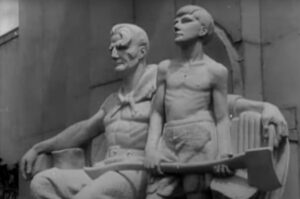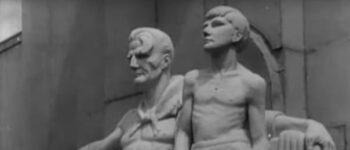1938: Trethewey’s Heroes
November 8, 2023
By AHNZ

Sculptor William Trethewey grew up in Christchurch during the 1890s Great Unraveling. Thus, he came of age in a crisis period when New Zealand needed heroes and heroic art. This picture (left) shows one of his works, now lost, of a Pioneer Generation father and son commissioned for the 1940 Centennial Exhibition (8 November 1939 – 4 May 1940.)
The plaster monuments were Tretheway’s last big commission and punctuated the end of New Zealand’s heroic era. Along with the pioneer males and females there were wonderful stylistic lions and a large panel illustrating New Zealand’s progress. The great survivor from the set was Kupe, the mythical discover of New Zealand, with his wife and witch doctor. All made of plaster, the only survivor is Kupe’s sculpture which has also been re-made in bronze and this endures on display at Wellington’s waterfront today.
New Zealand of the early C20th had an appetite for heroes that Trethewey was there to feed. After a ‘Woke’ Liberal era that picked apart and denigrated the pioneers in the late 1800s in a ‘great socialist experimental laboratory’ it was time for the pendulum to swing back. It became fashionable, even economically required and essential to our collective mental health and self-esteem, to celebrate the productive New Zealander again both the living and the dead. The Extinctionists’ day was done and we turned back to the heroic pro-human culture we New Zealand was founded upon.
For example, in 1912 the The Kokatahi Band was founded as a revivalist music group playing the retro music of the 1860s. Ref. 1912: The Kokatahi Band, AHNZ
Politically, New Zealand switched to a new heroic hegemony when William Massey’s Reform Ministry was elected to power in 1912. The farmer ‘heroes’ took back the streets, towns, and cities by becoming special deputies (Massey’s Cossacks) and bopping all the Lefties on their heads from horseback. Ref. 1913: The Great Strike Boogaloo, AHNZ
The 1910s re-characterised New Zealand with aggressive institutions and parochialism directed to local territory. Far from the ‘diverse’ and ‘multicultural’ focus, each New Zealand territory set its collective mind to doing right by itself and its core members. For example, institutions like The Southland Progress League sprang up and we have an explicit manifesto from 1918 dedicated to civic-minded commercial success and other values. Ref. The Southland Creed Renewed, AHNZ
In 1918 the new House of Representatives Debating Chamber was set in timber with this new outlook and it has not been swept away into the dust of history as easily as Trethewey’s plaster. Ref. 1918: Great War Debating Chamber, AHNZ
Of course, heroism was required and expressed in The Great War. In its aftermath New Zealand heroes started achieving feats of pioneering in the sky itself. It would have been interesting to see what sculptures Trethewey could have made of our aviation heroes from the 1920s. Ref. 1920: Cook Strait Sky Captain, AHNZ
One of the representatives of this heroic early C20th was soldier Charles Upham who explicitly spoke of the Pioneer Spirit. Trethewey’s public art works had been unveiled during his life and their perspective nourished his worldview. Just as Trethewey’s style left the art world it was remarked by Upham that this spirit had become unpopular and would be out of our blood (again) in just 1 generation to come. Ref. 1961: Upham Interview- Not Dark Yet, AHNZ
This 1939 public art commission was Trethewey’s last big job before the appreciation for his heroic vision of New Zealand became dark. The awe-inspiring creations were not even valued enough to be preserved and many of his creations have been lost and presumed destroyed.
“It is not abstract principles that a child learns from Romantic art, but the precondition and the incentive for the later understanding of such principles: the emotional experience of admiration for man’s highest potential, the experience of looking up to a hero—a view of life motivated and dominated by values, a life in which man’s choices are practicable, effective and crucially important—that is, a moral sense of life.” – The Romantic Manifesto, Ayn Rand (1969)
“His monumental realistic style became increasingly anachronistic, and after the Second World War New Zealanders were not interested in heroic stone memorials.” – Dictionary of New Zealand Biography, Te Ara
“Whatever happened to the heroes?
Whatever happened to the heroes?
No more heroes any more
No more heroes any more” – No More Heroes, Stranglers (1977)“He produced the statuary for the New Zealand Centennial Exhibition that was held in 1939/40 in Rongotai, Wellington. A 100 feet (30 m) frieze depicting the progress of New Zealand, groupings of pioneers, lions in Art Deco style, a large fountain and a figure of Kupe standing on the prow of his canoe were produced for the centennial exhibition. Of all these works, only the Kupe statue still remains.” – Wiki
“The modern mythology of Kupe reached its zenith in 1940. During the New Zealand Centennial Exhibition that year, held at Rongotai, in Wellington, the sculptor William T. Trethewey produced an elaborate allegorical figure called The Coming of the Maori. It was a 6.7-metre depiction of Kupe, his wife (Hine te Aparangi), and his tohunga. This epic piece was impregnated with even more symbolism by being perched on a pedestal in the stylised form of a canoe, which protruded into an ornamental pool at the Exhibition. The three figures in the scene were in dramatic, chiselled poses, with Kupe’s taiaha thrusting upwards, Hine te Aparangi’s arm outstretched, pointing to the promised land, and the aged tohunga exuding wisdom as he looked to the horizon. It was strongly evocative of the heroic Soviet and fascist statuary from the same period, and with a few minor modifications could easily have fitted into a public space in Moscow or Rome.” – Encounters, Paul Moon (2013)
“He may choose to present heroic figures, as exponents of man’s nature…or he may choose crawling specimens of depravity. He may present the triumph of heroes,…or he may demand sympathy for his monsters, and thus crawl outside the limits of the realm of values, including esthetic ones.” – Rand, ibid
As New Zealand moved out of its heroic era Trethewey put his energy into something else, clockmaking. What a typical high-tech and orderly object for people to prefer from William, the clock, at this time in history rather than what they wanted from him in youth. At least he knew how to be flexible with the times.
—
Image ref. One Hundred Crowded Years (1941), Archives NZ; Youtube
Image ref. Trethewey’s Art Deco Lion at the Centennial Exhibition. Alexander Turnbull Library, Digital New Zealand
2 thoughts on "1938: Trethewey’s Heroes"
Leave a Reply
 Like Comment Share
Like Comment Share






This article makes me even sadder when I see what is happening to our country, our democracy and our lives today.
Yes, or think of it is spiking the vollyball for the next Trethewey. If New Zealand doesn’t die then it’s due for another great heroic cycle kicking off later this decade. Good times ahead. The coming spirited generation wont even know about Trethewey or that they’re walking in the pathway of those who came before. I hope they find this post.